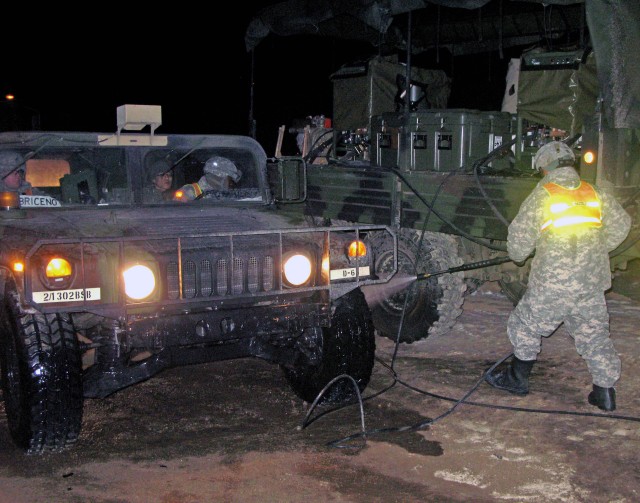
CAMP CASEY, South Korea - Despite a short timeline and concerns over Hoof and Mouth Disease, a joint effort between 4th Squadron, 7th Cavalry Regiment and 4th Chemical Company, Brigade Special Troops Battalion, 1st Heavy Brigade Combat Team, made January's gunnery training possible for several units within the brigade.
The success of the mission resulted in the opportunity for Soldiers with 4-7th Cav., 2nd Battalion, 9th Infantry Regiment, and 1st Battalion, 72nd Armor Regiment to qualify their gunnery tables in the winter months and for the chemical company's personnel to put their training to the test.
First Lieutenant Ben Peeler, 3rd platoon leader, 4th Chem. Co., said he was very pleased with the opportunity.
"This was a great chance for us to test our equipment in sub-zero temperatures," he said. "I think we have a better understanding of our equipment."
In addition, the Soldiers of the 4th Chem. Co. worked closely with troopers from 4-7th Cav.
Staff Sgt. Larry Curtis, the 4-7th Cav. Chemical, Biological, Radiological and Nuclear noncommissioned officer, shared Peeler's enthusiasm for the mission.
"All of our Chemical Operations Specialists have been active in this process," he said. "I'm glad that we had an opportunity to interact with the Republic of Korea Soldiers as well. We're getting our training done, and still helping our host nation."
Hoof and mouth disease is a viral disease that causes high fever and blisters in the mouth of cloven-hoofed animals. It has been a serious problem in recent years, and it returned in November with devastating results. Although the disease poses little threat to humans, HMD has taken a toll on cattle, pigs, sheep and other livestock due to its highly infectious nature. The disease is especially resistant during the winter months when cold weather forces cattle to huddle indoors. It can be passed through contact with aerosols, clothes, farming equipment or vehicles.
The heavy tactical vehicles of the Brigade were of particular concern since they would have to move from Camp Casey to the Rodriguez Live Fire Complex and Chipori range sites. In order to execute training, 1st HBCT leaders established a plan to mitigate the spread of the disease that had already demanded the culling of approximately 12% of the South Korean pig population and more than half a million head of cattle.
Working in partnership with the local government, 4-7th Cav. developed a strategy to ensure all tactical vehicles would not spread the disease.
Lt. Col. Mike Adams, 4-7th Cav. commander, shared the concerns of South Korean leaders, and wanted to conduct gunnery training that would not intensify an already potent viral outbreak.
"As recent events on the Korean Peninsula have demonstrated, maintaining our ability to 'fight tonight' is critical," he said. "Equally important is the application of these procedures to ensure we are in no way exacerbating the spread of this terrible virus and causing any further harm to the Korean agricultural industry."
Soldiers set up decontamination sites at both Rodriguez Life Fire Complex and Chipori Range. By doing so, they were able to duplicate the efforts already performed by the local Korean personnel who had established checkpoints along convoy routes in cities like Dongducheon, Yeoncheon, and Jeonguk. While vehicle spray points were strategically placed in the boundaries of each township to decontaminate passing vehicles, U.S. Army spray points in and out of training areas allowed the CBRN personnel to provide additional decontamination to larger vehicles like Bradley Fighting Vehicles.
The 1st HBCT stations were an effective addition to the ROK's decontamination stations, said Adams.
With two-pump trucks at each location, the Soldiers were able to support the mission with the same equipment that would be used in any other chemical decontamination situation.
"These pumps are the same ones we would use if there was an actual chemical threat or contamination," said Peeler.
Each pump carries a sodium chlorine compound, similar to pool water, which is sprayed over the exterior of the vehicles. While the local ROK checkpoints are essentially automatic car washes misting vehicles as they pass, the CBRN stations use manual spray hoses. This extra attention ensures that the vehicles are effectively coated. The 1st HBCT decontamination line only takes about a half hour to set up before vehicles can effectively move through the gauntlet of spray hoses.
With multiple battalions able to qualify their vehicles in gunnery training and the CBRN personnel able to cross-train with 4-7th Cav. in a practical environment, the entire effort could not have been a greater success, Adams said.
Peeler truly valued the experience, saying, "I think that the Soldiers appreciate the chance to come out here and prove that they are a valuable asset. It's great to see that the Brigade is using us in a capacity that shows that we are versatile and that we have the ability to be a force multiplier."

Social Sharing